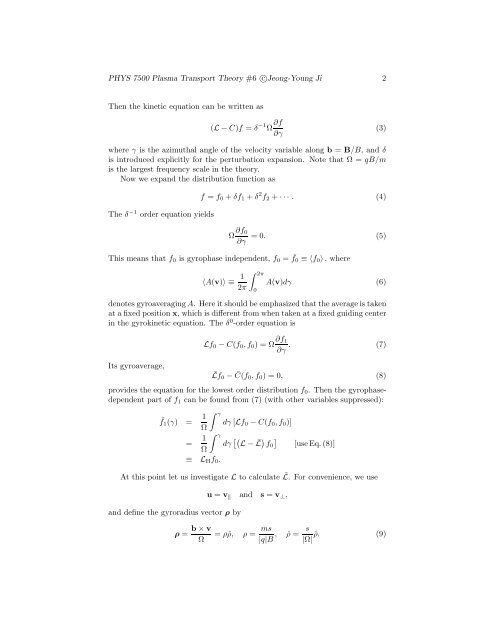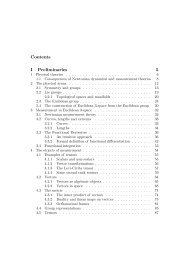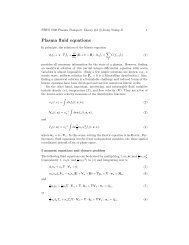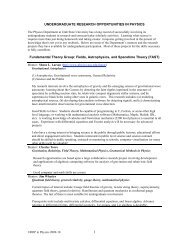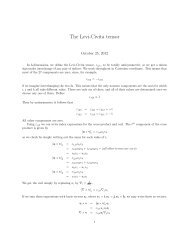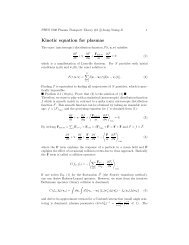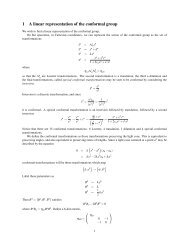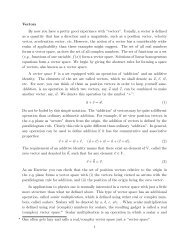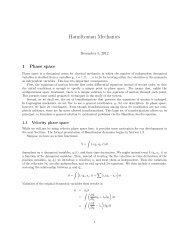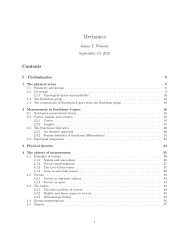Drift kinetic equation and neoclassical transport theory
Drift kinetic equation and neoclassical transport theory
Drift kinetic equation and neoclassical transport theory
You also want an ePaper? Increase the reach of your titles
YUMPU automatically turns print PDFs into web optimized ePapers that Google loves.
PHYS 7500 Plasma Transport Theory #6 c○Jeong-Young Ji 2<br />
Then the <strong>kinetic</strong> <strong>equation</strong> can be written as<br />
(L − C)f = δ −1 Ω ∂f<br />
∂γ<br />
(3)<br />
where γ is the azimuthal angle of the velocity variable along b = B/B, <strong>and</strong> δ<br />
is introduced explicitly for the perturbation expansion. Note that Ω = qB/m<br />
is the largest frequency scale in the <strong>theory</strong>.<br />
Now we exp<strong>and</strong> the distribution function as<br />
The δ −1 order <strong>equation</strong> yields<br />
f = f 0 + δf 1 + δ 2 f 2 + · · · . (4)<br />
Ω ∂f 0<br />
∂γ<br />
= 0. (5)<br />
This means that f 0 is gyrophase independent, f 0 = ¯f 0 ≡ 〈f 0 〉, where<br />
〈A(v)〉 ≡ 1<br />
2π<br />
∫ 2π<br />
0<br />
A(v)dγ (6)<br />
denotes gyroaveraging A. Here it should be emphasized that the average is taken<br />
at a fixed position x, which is different from when taken at a fixed guiding center<br />
in the gyro<strong>kinetic</strong> <strong>equation</strong>. The δ 0 -order <strong>equation</strong> is<br />
Lf 0 − C(f 0 , f 0 ) = Ω ∂f 1<br />
∂γ . (7)<br />
Its gyroaverage,<br />
¯Lf 0 − ¯C(f 0 , f 0 ) = 0, (8)<br />
provides the <strong>equation</strong> for the lowest order distribution f 0 . Then the gyrophasedependent<br />
part of f 1 can be found from (7) (with other variables suppressed):<br />
˜f 1 (γ) =<br />
1 Ω<br />
∫ γ<br />
dγ [Lf 0 − C(f 0 , f 0 )]<br />
= 1 Ω<br />
∫ γ<br />
dγ [( L − ¯L ) f 0<br />
]<br />
[use Eq. (8)]<br />
≡ L H f 0 .<br />
At this point let us investigate L to calculate ¯L. For convenience, we use<br />
u = v ‖ <strong>and</strong> s = v ⊥ ,<br />
<strong>and</strong> define the gyroradius vector ρ by<br />
ρ = b × v<br />
Ω<br />
= ρˆρ, ρ =<br />
ms<br />
|q|B ,<br />
ˆρ = s ˆρ. (9)<br />
|Ω|


